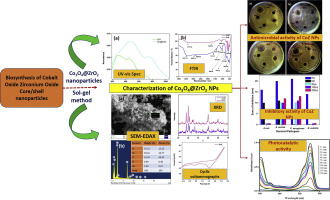当前位置:
X-MOL 学术
›
J. Photochem. Photobiol. B Biol.
›
论文详情
Our official English website, www.x-mol.net, welcomes your
feedback! (Note: you will need to create a separate account there.)
Core/shell nanoparticles: Synthesis, investigation of antimicrobial potential and photocatalytic degradation of Rhodamine B.
Journal of Photochemistry and Photobiology B: Biology ( IF 3.9 ) Pub Date : 2019-12-03 , DOI: 10.1016/j.jphotobiol.2019.111729 Rajasree Shanmuganathan 1 , Felix LewisOscar 2 , Sabarathinam Shanmugam 3 , Nooruddin Thajuddin 4 , Sulaiman Ali Alharbi 5 , Naiyf S Alharbi 5 , Kathirvel Brindhadevi 6 , Arivalagan Pugazhendhi 6
Journal of Photochemistry and Photobiology B: Biology ( IF 3.9 ) Pub Date : 2019-12-03 , DOI: 10.1016/j.jphotobiol.2019.111729 Rajasree Shanmuganathan 1 , Felix LewisOscar 2 , Sabarathinam Shanmugam 3 , Nooruddin Thajuddin 4 , Sulaiman Ali Alharbi 5 , Naiyf S Alharbi 5 , Kathirvel Brindhadevi 6 , Arivalagan Pugazhendhi 6
Affiliation

|
Bacterial pathogenicity is becoming a major cause of morbidity and mortality around the globe. Researchers are tirelessly finding solutions to cure or prevent infections caused by bacterial pathogens. Nanotechnology is a fast-growing area of research, effectively influencing and preventing bacterial growth. Nanoparticles (NPs) of silver, copper and gold are being used to kill bacterial pathogens in the past years but the toxicity of NPs at higher concentrations remains a major problem. Therefore, in the present study, Co3O4@ZrO2 (CoZ) core/shell NPs were synthesized using a simple sol-gel method. The synthesized NPs were characterized using different analytical techniques revealing the absorption bands at 456 and 277 nm with crystalline size of ~600 nm core/shell. The functional groups and oxidation states were characterized using FTIR analysis. Further bactericidal properties of core/shell of Co3O4@ZrO2 NPs were tested against Gram negative (Escherichia coli, Pseudomonas aeruginosa) and Gram positive (Staphylococcus aureus, Bacillus subitilis) pathogens. The core/shell CoZ NPs showed maximum growth inhibitions against S. aureus and P. aeruginosa. At the highest concentration of 200 μg/mL, the maximum zone of inhibition was observed. The synthesized CoZ NPs was also subjected to photocatalytic degradation of rhodamine B in 180 min under visible light irradiation. The present study could be an innovative and efficient research for both biomedical and wastewater treatment applications.
中文翻译:

核/壳纳米粒子:罗丹明B的合成,抗菌潜力的研究和光催化降解。
细菌致病性正在成为全球发病率和死亡率的主要原因。研究人员正在不懈地寻找解决方案,以治愈或预防由细菌病原体引起的感染。纳米技术是一个快速发展的研究领域,可以有效地影响和预防细菌的生长。在过去的几年中,银,铜和金的纳米颗粒(NPs)被用于杀死细菌病原体,但是高浓度NPs的毒性仍然是一个主要问题。因此,在本研究中,使用简单的溶胶-凝胶法合成了Co3O4 @ ZrO2(CoZ)核/壳NP。使用不同的分析技术对合成的NP进行了表征,揭示了在456和277 nm处的吸收带,核/壳的晶体大小约为600 nm。使用FTIR分析表征官能团和氧化态。测试了Co3O4 @ ZrO2 NP核/壳的进一步杀菌特性,以抵抗革兰氏阴性(大肠杆菌,铜绿假单胞菌)和革兰氏阳性(金黄色葡萄球菌,枯草芽孢杆菌)病原体。核/壳CoZ NPs对金黄色葡萄球菌和铜绿假单胞菌显示最大的生长抑制作用。在最高浓度为200μg/ mL时,观察到最大的抑制区域。合成的CoZ NPs在可见光照射下也于180分钟内进行了罗丹明B的光催化降解。本研究可能是针对生物医学和废水处理应用的创新而有效的研究。枯草芽孢杆菌)病原体。核/壳CoZ NPs对金黄色葡萄球菌和铜绿假单胞菌显示最大的生长抑制作用。在最高浓度为200μg/ mL时,观察到最大的抑制区域。合成的CoZ NPs在可见光照射下于180分钟内也进行了罗丹明B的光催化降解。本研究可能是针对生物医学和废水处理应用的创新而有效的研究。枯草芽孢杆菌)病原体。核/壳CoZ NPs对金黄色葡萄球菌和铜绿假单胞菌显示最大的生长抑制作用。在最高浓度为200μg/ mL时,观察到最大的抑制区域。合成的CoZ NPs在可见光照射下于180分钟内也进行了罗丹明B的光催化降解。本研究可能是针对生物医学和废水处理应用的创新而有效的研究。
更新日期:2019-12-04
中文翻译:

核/壳纳米粒子:罗丹明B的合成,抗菌潜力的研究和光催化降解。
细菌致病性正在成为全球发病率和死亡率的主要原因。研究人员正在不懈地寻找解决方案,以治愈或预防由细菌病原体引起的感染。纳米技术是一个快速发展的研究领域,可以有效地影响和预防细菌的生长。在过去的几年中,银,铜和金的纳米颗粒(NPs)被用于杀死细菌病原体,但是高浓度NPs的毒性仍然是一个主要问题。因此,在本研究中,使用简单的溶胶-凝胶法合成了Co3O4 @ ZrO2(CoZ)核/壳NP。使用不同的分析技术对合成的NP进行了表征,揭示了在456和277 nm处的吸收带,核/壳的晶体大小约为600 nm。使用FTIR分析表征官能团和氧化态。测试了Co3O4 @ ZrO2 NP核/壳的进一步杀菌特性,以抵抗革兰氏阴性(大肠杆菌,铜绿假单胞菌)和革兰氏阳性(金黄色葡萄球菌,枯草芽孢杆菌)病原体。核/壳CoZ NPs对金黄色葡萄球菌和铜绿假单胞菌显示最大的生长抑制作用。在最高浓度为200μg/ mL时,观察到最大的抑制区域。合成的CoZ NPs在可见光照射下也于180分钟内进行了罗丹明B的光催化降解。本研究可能是针对生物医学和废水处理应用的创新而有效的研究。枯草芽孢杆菌)病原体。核/壳CoZ NPs对金黄色葡萄球菌和铜绿假单胞菌显示最大的生长抑制作用。在最高浓度为200μg/ mL时,观察到最大的抑制区域。合成的CoZ NPs在可见光照射下于180分钟内也进行了罗丹明B的光催化降解。本研究可能是针对生物医学和废水处理应用的创新而有效的研究。枯草芽孢杆菌)病原体。核/壳CoZ NPs对金黄色葡萄球菌和铜绿假单胞菌显示最大的生长抑制作用。在最高浓度为200μg/ mL时,观察到最大的抑制区域。合成的CoZ NPs在可见光照射下于180分钟内也进行了罗丹明B的光催化降解。本研究可能是针对生物医学和废水处理应用的创新而有效的研究。










































 京公网安备 11010802027423号
京公网安备 11010802027423号